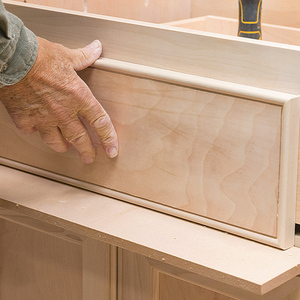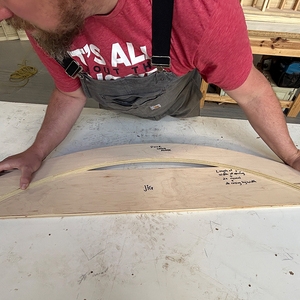*
I used to have this written down, but I have lost the formula.
Can anyone tell me how to find the radius of an arch that is not the full diameter, as if the top of a circle were cut off? Fine Homebuilding had this in a sidebar some time back, and you could find the Radius if you new the vertical height of the arch and the horizontal length.
Thank you, Brent.
Discussion Forum
Discussion Forum
Up Next
Video Shorts
Featured Story

Whether it’s already in your house or picked up at a flea market, vintage hardware almost always needs help.
Featured Video
SawStop's Portable Tablesaw is Bigger and Better Than BeforeHighlights
"I have learned so much thanks to the searchable articles on the FHB website. I can confidently say that I expect to be a life-long subscriber." - M.K.
Fine Homebuilding Magazine
- Home Group
- Antique Trader
- Arts & Crafts Homes
- Bank Note Reporter
- Cabin Life
- Cuisine at Home
- Fine Gardening
- Fine Woodworking
- Green Building Advisor
- Garden Gate
- Horticulture
- Keep Craft Alive
- Log Home Living
- Military Trader/Vehicles
- Numismatic News
- Numismaster
- Old Cars Weekly
- Old House Journal
- Period Homes
- Popular Woodworking
- Script
- ShopNotes
- Sports Collectors Digest
- Threads
- Timber Home Living
- Traditional Building
- Woodsmith
- World Coin News
- Writer's Digest


















Replies
*
HA! Answered my own question. R=(c2 + 4h2)/(8h)
R= Radius
c= chord (horizontal measurement)
h= height from center of chord to top of arch.
*Mass Just want ot make sure I got it right is it Radius equals chord squared + four times the hieght squared divided by eight times the hieghtThanks Jimps I always forget where I put this one all the time
*That's correct. As a precaution, I started a file in my computer for tidbits like this that I really should remember, and am in the process of making a binder too. Maybe once I get everything together I will make a laminated card to keep in my truck. Brent.
*I'm not sure if this will help or not, but I don't use a formula, I snap it out on the subfloor. Most of the arches I build are not more then 10 or 12 feet in lenght so this works rather well for me. I start out by snaping a 6-8-12 on the subfloor and continue the lines out to make a "plus" sign on the floor. Lets say the arch is 2' tall and 6' wide. At the point of interescting lines of your "plus" sign, come up two feet and mark it with your pencil. From the center again, 90 degrees from your 2' mark on the lines, mark 3' which is your radius in this example. Snap a line from your 2' mark and your 3' mark and find the center of that line. Coming of this new line 90 degrees again, where ever it hits your original 6-8-12 line will be where you would set your nail. Once the nail is set, I get out my tape and pull it out to the 3 foot mark, I scribe the arch with my pencil keeping it on the same number (what ever that number might be) on the tape to keep the arch smooth and consistant. I don't know if this helps you or not, but its the fastest, most acurate way to swing an arch. If I did this right, there should be a little drawing of what I'm trying to explain. The picture will need to be opened with Kodak imaging and can be found with anyone with Windows by going to: start>programs>accessories>imaging Jeffro
*I like jeffro idea of finding an arch. Mine is similiar. I start with a 6'8'10' square pattern instead of a 6,8,12 for square. I use the same way to find the arch as jeffro. Then I mark the three points of the arch and use three tape measures. put a nail at each point and hook a tape at each location. Pull all three tapes down the center line of the arch and when all the tapes read the same you have the center point of the radius.Jcool
*i can't ever remember the formula either and probably because it was a bunch of numbers that didn't make sense to me to use.What makes sense to me uses trig which is the same as using ratios or proportions of something you know to get something you dont.If you were to use the vertical leg and half the horizontal leg as two legs of a right triangle, connect the end points to make a triangle, divide that diagonal leg measurement by the short vertical leg measurement to get the ratio and then multiply that ratio by half the diagonal leg measurement, the answer will give you the radius.For example if 36" was the vertical leg and 48" half the horizontal leg and 60" the diagonal you would divide 36 into 60 to get 1.666 which you would multiply by 30 (half the diagonal leg) to get 50 " the radius. It makes sense( proportionally) when you see that squaring off the halfway point of the diagonal line (the hypotenuse) will intersect the extended vertical leg at the radius point and that it's the same angled triangle as the one formed by half the horizontal leg and the whole vertical leg you started with .Drawing it out helps it all make sense.On smaller archs it's fast just to draw it out and use a square but over about 8 ft radiuses it's faster for me to get the ratio.With trig it's even faster and with the formula you or i can't recall probably the fastest.If i forget it all i can always pull 3 tapes or square it out on the subfloor.I bet the construction master calculator does it with 7 simple keystrokes.
*boyd,
*Two easy formulas for you to use:1)2AY=A(squared)+ B(squared)where A= height of the arch from the center of the chord; Y= the radius in question; B= 1/2 chord lengthMethod 2) Using a Construction Master IV:(Actually the same formula - adapted to the CMIV-enter the "height of the arch from the chord" , press "Rise"Enter 1/2 chord length as "RUN"Press "DIAG", then "CONV" "SQRT"(Square root sign)divide the result by (2)Divide that result by "RISE".Try it - it works fast and easy. In practice, I take a four foot level, measure off exactly to the halfway mark (24" for you mathmatically challenged), and hold it underneath the arch. I then measure up from the center mark with a combination square to find the arch height. That and my CM IV is all I need to quickly calculate any true radius from an arch.(Assumption: the arch you are measuring is a true radius, not ovate or double radius. - You can check for this by taking the same measurement several places on the arch).I use this technique often when making custom arch trim on my RBI molder.Ken - the Sweaty Carpenter
*In response to Joseph's post(hey Joseph) that i left out the step of figuring for the length of the diagonal connecting line ( hypotenuse) between the vertical leg and half the horizontal leg by expressing it as a given and thus not as short a solution as i made it out to be.....What i tried to describe as "another" way to get the radius is actually even a longer process than the straight math Joseph ( "faster with trig") understood me to be using in that i was describing marking and measuring the lines on the subfloor and taping the diagonal (hypotenuse) to get it's length to divide by the the vertical leg to get the ratio to multiply by half the diagonal line to get the radius.I mention this way of doing it for someone who is'nt familiar with trig or squared/square root formulas but knows how to divide and multiply(with a calculator) and draw a picture and after doing it once won't forget it because it just makes sense.And for myself i should write down the formula Joseph gave on a piece of duct tape and tape it inside my calculator where i don't have to make sense of it to remember it and thus have the fastest solution of them all.(Untill Construction Master Calculator programs... Rise, run, radius.)
*I have been following this discussion.Here is a way if you have a trig function calculator. Let C= chord H= rise @ mid point. 2*H/C press (arctan)* 2 = press(sin) Press(1/X) * C / 2 = Radius sought.
*Rocky,Your method for finding the radius of a circle is interesting. Because the method involves using some trig functions, it's definitely not going to gain wide appeal of the masses, but it is accurate, and works just as well as other formulas shown in this thread.For those readers ( very few, I imagine) who would like to understand why this method works, here's an explanation. (See the diagram below.)In the diagram, Suppose the length of the chord BD (the rough opening), is equal to C. If M is the midpoint of the chord, then BM = C/2Also, let the height of the arc = H, and the unknown radius of the circle = R, as shown.In right triangle ABM, Tan(angle ABM) = H/(C/2)= 2H/CTherefore, Angle ABM = Tan-1(2H/C)In right triangle BOM, angle BOM will always be exactly twice as large as angle ABM. (I'll give an explanation in another post if anyone is curious)So we have, Angle BOM = 2*Tan-1(2H/C)and in right triangle BOM, sin(angle BOM) = (C/2)/R, which can be written as,R = (C/2)/sin(BOM)Now, if you look at Rocky's Formula,2*H/C press (arctan)* 2 = press(sin) Press(1/X) * C / 2 = Radius the first part, 2*H/C press (arctan)*2, gives you the measure of angle BOM. The second part of his formula, finds the sine of angle BOM, inverts it, and the result is then multiplied by C/2. The answer is the Radius.
*Your sure getting some great math answers. How about this one. To find the the point of radius for any circle or arc without the math, all you will need is some string and a pencil.Charlie Morrison
*That is how it is done.Are you waiting for the image to finish uploading before going to another page, back the original, etc ?Also, forgive me if this sounds too simple. From your description, you are finding your file, clicking on it, and then hitting "post my message". Are you hitting "open" after you click on your file ?ie, hit browse. Find file and click on it. Select "open". Then, when the browse window disappears, you are back at this page with the post my message button, and your filename and path now appears in the little box beside the browse button. Then you hit the post message button. Then you wait for the upload to finish. When it is finished you will see your new post, with the blue image link in it.
*Thank you for all the great input guys.I'm glad I get to see WHY it works...that helps.The reason that I use this particular method is because I do not need a Trig function, nor do I need to use a few tapes or strings to find it. Just the tape in my bags, and in a pinch I don't even need a calculator. With my trusty CM IV it is literally a two minute operation.Brent Jackson.
*Now let us see if I can get this Atachment to post this time.Charlie Morrison
*Good show !!b : )
*Anybody know waht issue this was in? I was thinking the same thing but I couldn't find the issue, or page of the issues that I looked in.
*luka,R=(((L/2)2)/H+H)/2 this mess simplifies to L squared divided by 16H, if i'm reading this the right way...quantity (L divided by 2) squared, then divided by H + H (same as 2H, or 2 times H), all divided by 2.can't be the right interpretation...for L=6 and H=2, r=9/8where am i reading this equation incorrectly?brian
*ken,your formula simplifies to:d (squared)/ 2H, whereH=height of ellipsed=length of diagonal from top of ellipse to end of chordthis equation gives the right result in as simple terms as possible...brian
*practical example...for an ellipse window above a door, make a point above the door representing the desired height of the ellipse window, then measure to a point of your chosing for the lower corner of the ellipse window (practically speaking, this would be in-line with the outside edge of the door). this is "d".make a level line above the door off your window lower corner mark. with a square, measure from your height point down to the level line. this is "h".square the diagonal measure and divide this by double the height measure.this is your radius.no trig, no construction calculators, no floors, no rocket science necessary. but you need more than a string and pencil, i admit it...brian
*and here's a way to remember it...square one,square off the other,double and divide.brian
*buy a construction master pro. it will do it for youleigh
*more hundred dollar rocket science...brian
That wouldn't work for an ellipse. What you are describing is a segmental arch. I might be mistaken or misunderstand your post.